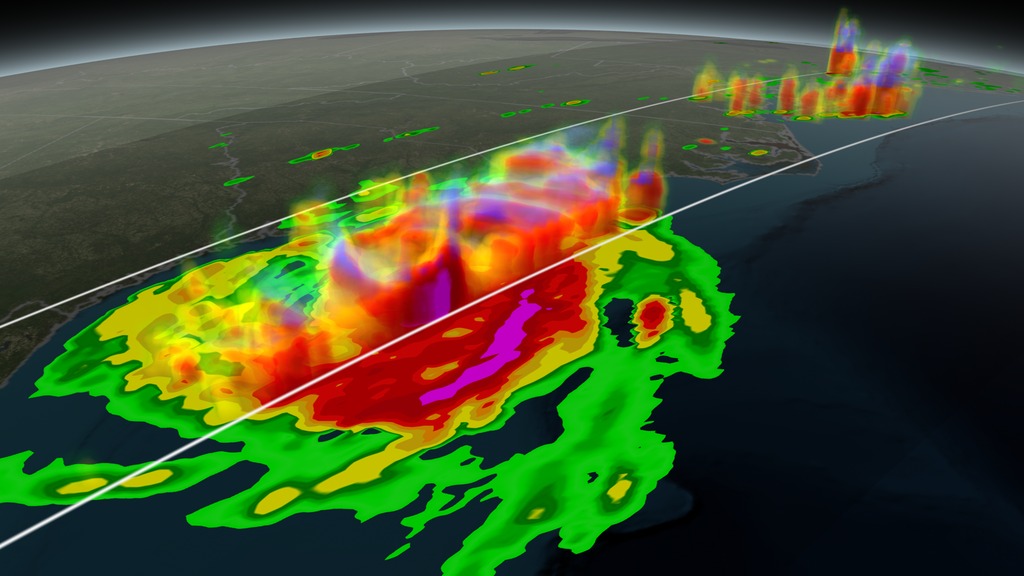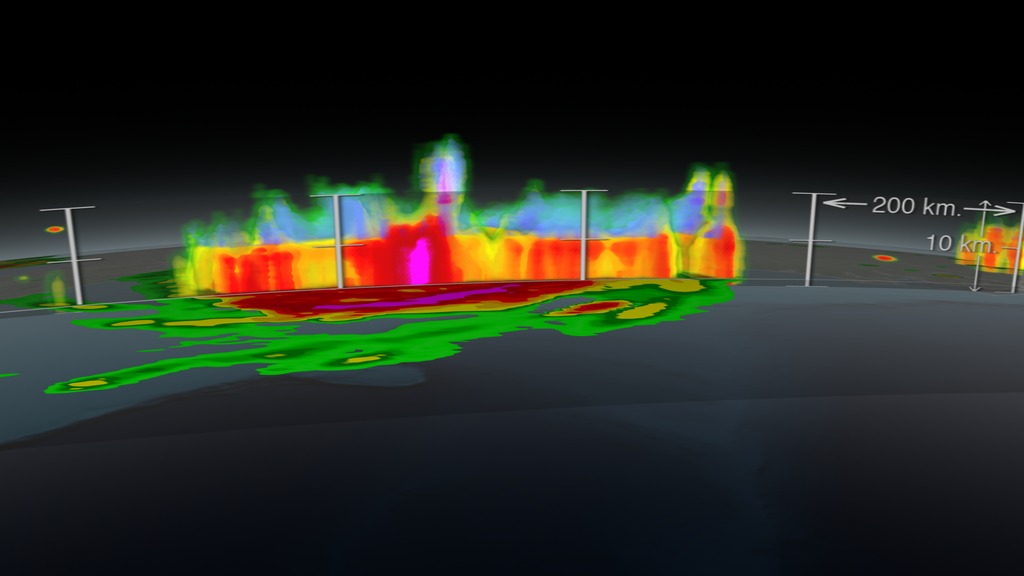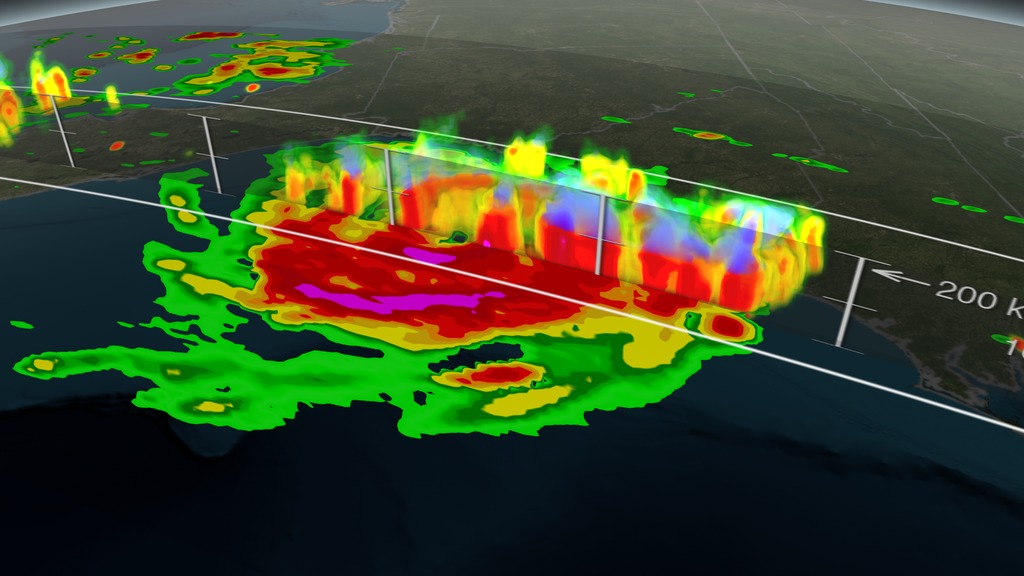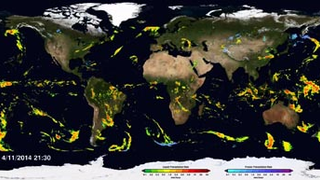Earth
ID: 4186
The Global Precipitation Measurement mission's Core Observatory flew over Hurricane Arthur five times between July 1 and July 6, 2014. Arthur is the first tropical cyclone of the 2014 Atlantic Hurricane season. It formed as a tropical storm on Tuesday, July 1 and reached maximum intensity as a Category 2 hurricane on July 4, disrupting some coastal U.S. Independence Day celebrations. This visualization is taken from the flyover on July 3, 2014 with Hurricane Arthur just off the South Carolina coast. GPM data showed that the hurricane was asymmetrical, with spiral arms, called rain bands, on the eastern side of the storm but not on the western side.
The GPM Core Observatory carries two instruments that show the location and intensity of the rain, which defines a crucial part of the storm structure – and how it will behave. The GPM Microwave Imager sees through the tops of clouds to observe how much and where precipitation occurs, and the Dual-frequency Precipitation Radar observes precise details of precipitation in 3-dimensions.
For forecasters, GPM's microwave and radar data are part of the toolbox of satellite data, including other low Earth orbit and geostationary satellites, that they use to monitor tropical cyclones and hurricanes.
The addition of GPM data to the current suite of satellite data is timely. Its predecessor precipitation satellite, the Tropical Rainfall Measuring Mission, is 18 years into what was originally a three-year mission. GPM's new high-resolution microwave imager data and the unique radar data ensure that forecasters and modelers won't have a gap in coverage. GPM is a joint mission between NASA and the Japan Aerospace Exploration Agency. The satellite launched Feb. 27, and after its check-out period began its prime mission on May 29, in time for hurricane season. All GPM data products will be released to the public by September 2, 2104. Current and future data sets are available to registered users from NASA Goddard's Precipitation Processing Center website.





GPM Dissects Hurricane Arthur
The GPM Core Observatory carries two instruments that show the location and intensity of the rain, which defines a crucial part of the storm structure – and how it will behave. The GPM Microwave Imager sees through the tops of clouds to observe how much and where precipitation occurs, and the Dual-frequency Precipitation Radar observes precise details of precipitation in 3-dimensions.
For forecasters, GPM's microwave and radar data are part of the toolbox of satellite data, including other low Earth orbit and geostationary satellites, that they use to monitor tropical cyclones and hurricanes.
The addition of GPM data to the current suite of satellite data is timely. Its predecessor precipitation satellite, the Tropical Rainfall Measuring Mission, is 18 years into what was originally a three-year mission. GPM's new high-resolution microwave imager data and the unique radar data ensure that forecasters and modelers won't have a gap in coverage. GPM is a joint mission between NASA and the Japan Aerospace Exploration Agency. The satellite launched Feb. 27, and after its check-out period began its prime mission on May 29, in time for hurricane season. All GPM data products will be released to the public by September 2, 2104. Current and future data sets are available to registered users from NASA Goddard's Precipitation Processing Center website.





Related
Visualization Credits
Alex Kekesi (Global Science and Technology, Inc.): Lead Animator
Greg Shirah (NASA/GSFC): Animator
Ryan Fitzgibbons (USRA): Producer
Rani Gran (NASA/GSFC): Producer
Gail Skofronick Jackson (NASA/GSFC): Scientist
George Huffman (NASA/GSFC): Scientist
Dalia B Kirschbaum (NASA/GSFC): Scientist
Laurence Schuler (ADNET Systems, Inc.): Project Support
Ian Jones (ADNET Systems, Inc.): Project Support
Chris Kidd (University of Maryland): Project Support
John M. Kwiatkowski (George Mason University): Project Support
William S. Olson (JCET/UMBC): Project Support
Ellen T. Gray (ADNET Systems, Inc.): Writer
Greg Shirah (NASA/GSFC): Animator
Ryan Fitzgibbons (USRA): Producer
Rani Gran (NASA/GSFC): Producer
Gail Skofronick Jackson (NASA/GSFC): Scientist
George Huffman (NASA/GSFC): Scientist
Dalia B Kirschbaum (NASA/GSFC): Scientist
Laurence Schuler (ADNET Systems, Inc.): Project Support
Ian Jones (ADNET Systems, Inc.): Project Support
Chris Kidd (University of Maryland): Project Support
John M. Kwiatkowski (George Mason University): Project Support
William S. Olson (JCET/UMBC): Project Support
Ellen T. Gray (ADNET Systems, Inc.): Writer
Please give credit for this item to:
NASA's Scientific Visualization Studio
NASA's Scientific Visualization Studio
Short URL to share this page:
https://svs.gsfc.nasa.gov/4186
Missions:
Global Precipitation Measurement (GPM)
Viking
Data Used:
Note: While we identify the data sets used in these visualizations, we do not store any further details nor the data sets themselves on our site.
This item is part of this series:
GPM Animations
Keywords:
DLESE >> Atmospheric science
SVS >> HDTV
DLESE >> Natural hazards
GCMD >> Earth Science >> Atmosphere >> Atmospheric Phenomena >> Hurricanes
GCMD >> Earth Science >> Atmosphere >> Precipitation >> Precipitation Rate
GCMD >> Earth Science >> Atmosphere >> Precipitation >> Rain
NASA Science >> Earth
GCMD keywords can be found on the Internet with the following citation: Olsen, L.M., G. Major, K. Shein, J. Scialdone, S. Ritz, T. Stevens, M. Morahan, A. Aleman, R. Vogel, S. Leicester, H. Weir, M. Meaux, S. Grebas, C.Solomon, M. Holland, T. Northcutt, R. A. Restrepo, R. Bilodeau, 2013. NASA/Global Change Master Directory (GCMD) Earth Science Keywords. Version 8.0.0.0.0
https://svs.gsfc.nasa.gov/4186
Missions:
Global Precipitation Measurement (GPM)
Viking
Data Used:
CPC (Climate Prediction Center) Cloud Composite
Data Compilation - Climate Prediction Center (CPC) - 7/1/14 - 7/3/14
Global cloud cover from multiple satellites
GPM/GMI/Surface Precipitation also referred to as: Rain Rates
7/3/14
Credit:
Data provided by the joint NASA/JAXA GPM mission.
Data provided by the joint NASA/JAXA GPM mission.
GPM/DPR/Ku also referred to as: Volumetric Precipitation data
Observed Data - JAXA - 7/3/14
Credit:
Data provided by the joint NASA/JAXA GPM mission.
Data provided by the joint NASA/JAXA GPM mission.
This item is part of this series:
GPM Animations
Keywords:
DLESE >> Atmospheric science
SVS >> HDTV
DLESE >> Natural hazards
GCMD >> Earth Science >> Atmosphere >> Atmospheric Phenomena >> Hurricanes
GCMD >> Earth Science >> Atmosphere >> Precipitation >> Precipitation Rate
GCMD >> Earth Science >> Atmosphere >> Precipitation >> Rain
NASA Science >> Earth
GCMD keywords can be found on the Internet with the following citation: Olsen, L.M., G. Major, K. Shein, J. Scialdone, S. Ritz, T. Stevens, M. Morahan, A. Aleman, R. Vogel, S. Leicester, H. Weir, M. Meaux, S. Grebas, C.Solomon, M. Holland, T. Northcutt, R. A. Restrepo, R. Bilodeau, 2013. NASA/Global Change Master Directory (GCMD) Earth Science Keywords. Version 8.0.0.0.0













